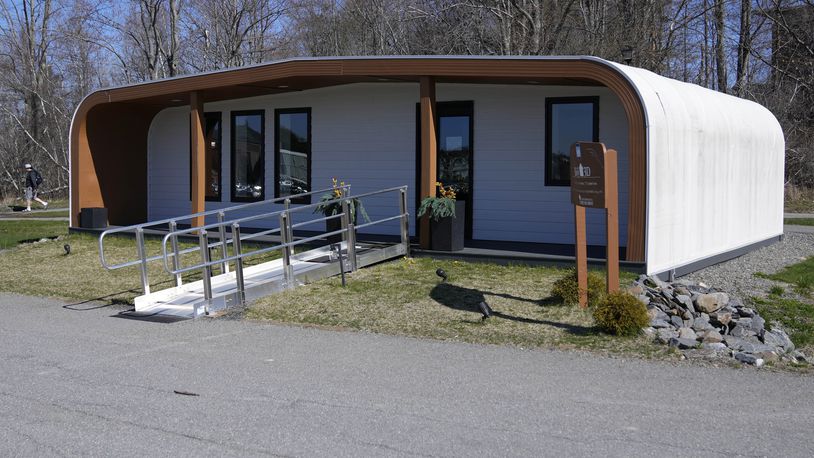Thermoplastic polymers are extruded from a printer dubbed the “Factory of the Future 1.0," said Habib Dagher, director of UMaine’s Advanced Structures & Composite Center, where both of the current printers are located. It combines robotics operations with new sensors, high-performance computing and artificial intelligence, Dagher said.
And there could be even larger printers in the future after the University of Maine breaks ground this summer on a new building.
“We’re learning from this to design the next one,” he said.
Those attending the event included representatives from departments of defense, energy and housing, as well as other stakeholders who plan to utilize the new technologies made available by the printer. Heidi Shyu, undersecretary of defense for research and engineering, said the printer exceeded her expectations and "stands as a beacon of innovation."
Shrouded by a black curtain, the printer was on and whirring behind the speakers during the event. At the end, the curtain opened revealing the printer was working on a test project for a future boat.
The printer's frame fills up the large building in which it’s housed on the UMaine campus, and can print objects 96 feet long by 32 feet wide by 18 feet high (29 meters by 10 meters by 5.5 meters).
It has a voracious appetite, consuming as much as 500 pounds (227 kilograms) of material per hour.
The original printer, christened in 2019, was certified by Guinness World Records as the world's largest polymer 3D printer, the university said. It was used to create a 600-square-foot, single-family home made of wood fiber and bio-resin materials that are recyclable. Dubbed "BioHome3D," it showed an ability to quickly produce homes. To meet the growing demand for housing, Maine alone will need another 80,000 homes over the next six years, according to MaineHousing.
Dagher said there's a shortage of both affordable housing and workers to build homes. The university wants to show how homes can be constructed nearly entirely by a printer with a lower carbon footprint. The buildings and construction sector accounts for roughly 37% of global greenhouse gas emissions, largely due to the production and use of materials such as cement, steel and aluminum that have a significant carbon footprint, according to the United Nations Environment Programme.
Such printed buildings can be recycled, which is unique compared to current construction. “You can basically deconstruct it, you can grind it up if you wish, the 3D printed parts, and reprint with them, do it again,” Dagher said before the event.
“It’s not about building a cheap house or a biohome,” he added, referring to the first 3D-printed house made entirely with bio-based materials. “We wanted to build a house that people would say, ‘Wow, I really want to live there.’”
The Army Corps of Engineers provided most of the funding for the new printer, which cost several million dollars, said Dannel Malloy, chancellor of the University of Maine System. It was built by the university in collaboration with Ingersoll Machine Tools Inc. for construction of the printer and Somatex for the supporting structure, officials said.
Looking ahead, researchers plan to tinker with the material consumed by the machine, including more bio-based feedstocks from wood residuals that are abundant in Maine, the nation’s most heavily forested state.
But it can be used for a variety of other creations and already has been used for a range of things, from boats to defense department structures. In the past, the university showed off a 25-foot boat created by the first printer. Upcoming projects with the new printer include a 50-foot boat and houses to serve homeless people, Dagher said.
As for the original 3D printer, it isn't going away. The two printers can be used in concert to streamline manufacturing by working on the same project — or even part if necessary — and there will be even more of them working together in the future, officials said.
___
McDermott reported from Providence, Rhode Island.
—-
This story has been corrected to indicate that one of the university's partners was Ingersoll Machine Tools Inc., not Ingersoll Rand.
Credit: AP
Credit: AP
Credit: AP
Credit: AP
Credit: AP
Credit: AP
Credit: AP
Credit: AP
Credit: AP
Credit: AP
Credit: AP
Credit: AP
Credit: AP
Credit: AP
